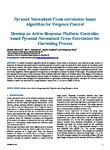Depth Estimation Based on Pyramid Normalized Cross-correlation Algorithm for Vergence Control
| dc.contributor.author | Mohamed, A | en |
| dc.contributor.author | Culverhouse, PF | en |
| dc.contributor.author | Cangelosi, A | en |
| dc.contributor.author | Yang, C | en |
| dc.date.accessioned | 2018-11-30T15:08:09Z | |
| dc.date.available | 2018-11-30T15:08:09Z | |
| dc.identifier.issn | 2169-3536 | en |
| dc.identifier.uri | http://hdl.handle.net/10026.1/12964 | |
| dc.description.abstract |
OAPA A depth estimation algorithm based on vergence vision using a mechanical joint attached to two cameras is proposed. A Gaussian pyramid template-matching approach is used to align the view of the slave camera to the fixation point of the master camera. The master camera uses an object detection algorithm to find the target’s centroid and centers it relative to the image coordinates. Then, vergence movement of the slave camera is performed using a pyramid normalized cross-correlation algorithm. Simple geometric triangulation is employed to compute the depth of that target. This proposed method was implemented using an active binocular vision platform with five degrees of freedom where four degrees of freedom to control the pan and tilt independently, and one degree of freedom to control the baseline which is the distance between the camera. This system was designed for implementation in agriculture harvesting applications. Analysis of field trial results indicates a worst-case precision of a target tomatoes’ depth to be ±1.32 cm at a depth of 85 cm. | en |
| dc.language.iso | en | en |
| dc.publisher | Institute of Electrical and Electronics Engineers (IEEE) | en |
| dc.rights | Attribution-ShareAlike 4.0 International | en |
| dc.rights | Attribution-ShareAlike 4.0 International | en |
| dc.rights | Attribution-ShareAlike 4.0 International | en |
| dc.rights | Attribution-ShareAlike 4.0 International | en |
| dc.rights.uri | http://creativecommons.org/licenses/by-sa/4.0/ | en |
| dc.rights.uri | http://creativecommons.org/licenses/by-sa/4.0/ | en |
| dc.rights.uri | http://creativecommons.org/licenses/by-sa/4.0/ | en |
| dc.rights.uri | http://creativecommons.org/licenses/by-sa/4.0/ | en |
| dc.title | Depth Estimation Based on Pyramid Normalized Cross-correlation Algorithm for Vergence Control | en |
| dc.type | Journal Article | |
| plymouth.journal | IEEE Access | en |
| dc.identifier.doi | 10.1109/ACCESS.2018.2877721 | en |
| plymouth.organisational-group | /Plymouth | |
| plymouth.organisational-group | /Plymouth/Faculty of Science and Engineering | |
| plymouth.organisational-group | /Plymouth/Faculty of Science and Engineering/School of Engineering, Computing and Mathematics | |
| plymouth.organisational-group | /Plymouth/REF 2021 Researchers by UoA | |
| plymouth.organisational-group | /Plymouth/REF 2021 Researchers by UoA/UoA11 Computer Science and Informatics | |
| plymouth.organisational-group | /Plymouth/Research Groups | |
| plymouth.organisational-group | /Plymouth/Research Groups/Institute of Health and Community | |
| plymouth.organisational-group | /Plymouth/Research Groups/Marine Institute | |
| dcterms.dateAccepted | 2018-10-10 | en |
| dc.rights.embargodate | 2019-01-11 | en |
| dc.identifier.eissn | 2169-3536 | en |
| dc.rights.embargoperiod | Not known | en |
| rioxxterms.versionofrecord | 10.1109/ACCESS.2018.2877721 | en |
| rioxxterms.licenseref.uri | http://creativecommons.org/licenses/by-sa/4.0/ | en |
| rioxxterms.type | Journal Article/Review | en |



